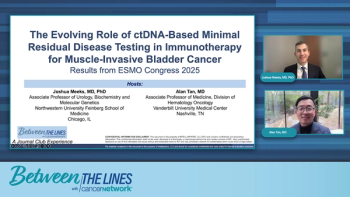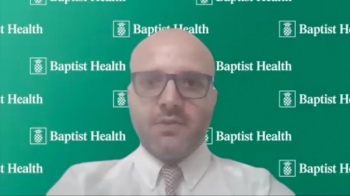
Clinical Scenario: When Would You Offer LCT?
Panelists discuss how the decision to offer local consolidative therapy in oligometastatic non–small cell lung cancer depends on multiple factors including PET scan activity at 6 months, the feasibility of rendering patients with no evidence of disease, multidisciplinary collaboration, and the emerging need for a “third box” treatment category beyond curative and palliative intent that addresses preemptive strikes against limited progressive sites to prolong survival.
Episodes in this series

Clinical Scenario: When Would You Offer LCT?
The case involved a patient with metastatic non–small cell lung cancer who had excellent response to pembrolizumab-based chemotherapy in the chest but a stable liver lesion. After stereotactic body radiation therapy to the liver rendered that site undetectable, the question was whether to pursue consolidative thoracic radiation for residual chest disease. Clinicians emphasized that heterogeneity matters—not just seeing “2-cm tumor and small nodes” but understanding the actual imaging, disease distribution, and potential toxicity from treatment fields. PET scan response at approximately 6 months emerged as a critical decision-making tool, with PET-negative residual disease potentially not requiring radiation vs PET-positive disease warranting treatment to prevent progression.
Different institutional approaches were discussed. Some favor treating after maximal systemic response (typically at least 6 months), while others use PET metabolic activity to guide decisions—treating active disease while deferring radiation for metabolically complete responses. The rationale synthesized findings from multiple trials: NRG-LU002’s negative results in the immunotherapy era suggest responding patients continue responding without local therapy, while the CURB trial showed benefit for treating progressing sites. This led to using PET as a “pre-progression marker”—persistent metabolic activity at 6 months predicting eventual progression and warranting preemptive local therapy.
The discussion highlighted the need for a “third box” beyond curative and palliative intent—treating with ablative doses to achieve durable local control of limited progressive sites, prolonging time on effective systemic therapy even when cure is unlikely. This concept of “preemptive strike” radiation faces insurance approval challenges since it doesn’t fit traditional paradigm categories. Multidisciplinary collaboration including pulmonologists for management was emphasized. Regarding subsequent management after rendering patients with no evidence of disease, practices varied from continuing maintenance immunotherapy for 2 years to using PET and circulating tumor DNA to guide treatment discontinuation decisions in patients achieving complete metabolic responses.
Newsletter
Stay up to date on recent advances in the multidisciplinary approach to cancer.























































































